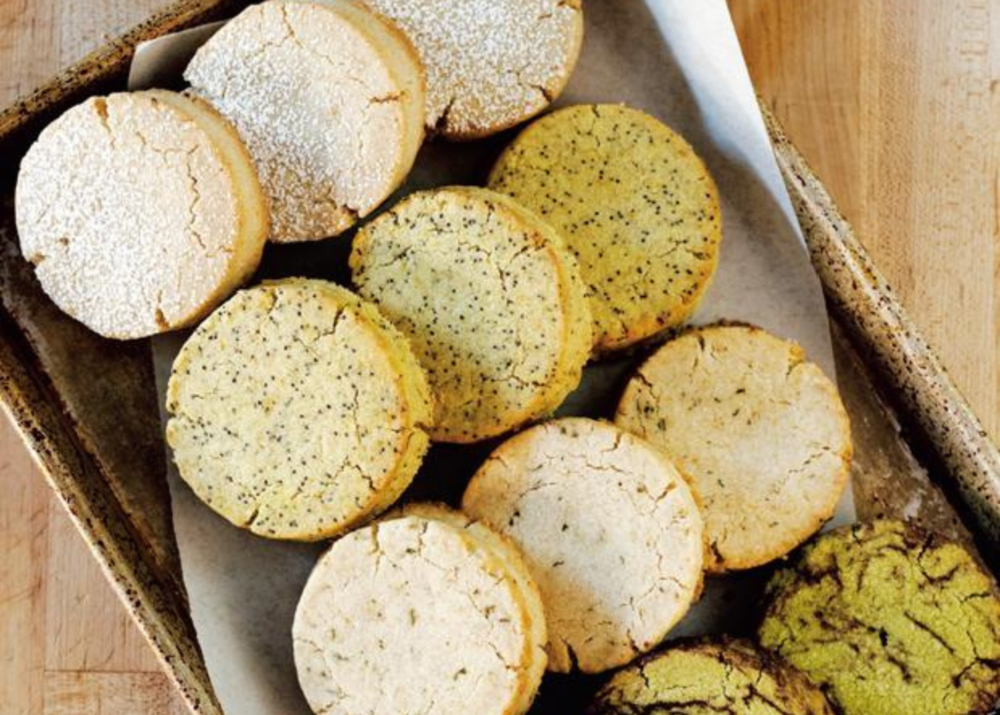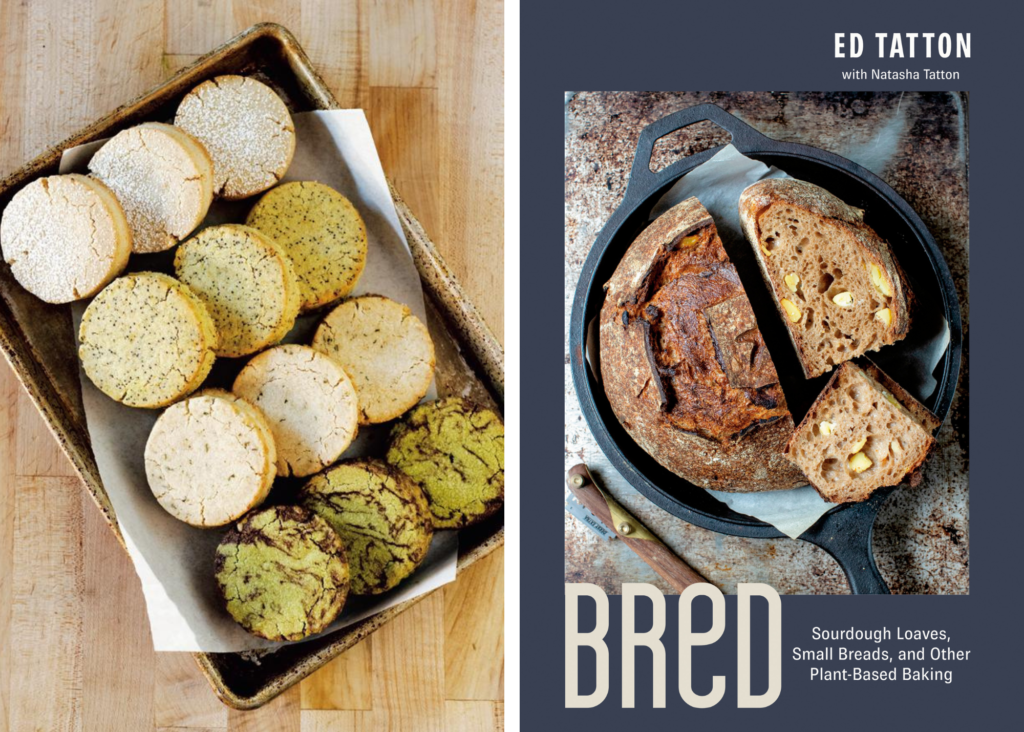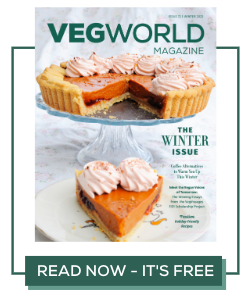
My grandparents were from Scotland, where shortbread is traditionally given at weddings and to the “first footers” of New Year. My grandfather passed on while I was writing this book, and shortbread was the last Christmas gift I ever gave him. Shortbread itself goes back at least to the time of Mary, Queen of Scots, who liked it with caraway seeds in, apparently.
Shortbread is butter-heavy by nature, and it is rare to find plant-based shortbread anywhere, though good- quality vegan butter makes for an excellent cruelty-free version of this classic biscuit. We opt for Earth Balance, as they source from Roundtable on Sustainable Palm Oil organizations, and it is easily available in BC, but there are other palm-free vegan butters out there that you could use instead, such as Naturli’s or Miyoko’s. The goal is a buttery texture that melts in your mouth but is soft and crumbly at the same time.
This shortbread is best the day it is baked, so I like to cut and bake only as many as I need at one time, and keep the remaining dough refrigerated.
Excerpted from BReD by Edward Tatton and Natasha Tatton. Copyright © 2023 Edward Tatton and
Natasha Tatton. Photography by Janis Nicolay. Published by Penguin, an imprint of Penguin Canada, a
division of Penguin Random House Canada Limited. Reproduced by arrangement with the Publisher. All rights reserved.

Scottish Shortbread
ED TATTON is a professional chef who has been to culinary college and worked in high-end kitchens in the UK, Australia, New Zealand as well as Canada, but now specialises in making organic naturally leavened sourdough, baking bread, pizza dough, and other small baked goods. These days, Ed’s food is compassionately 100% plant-based, a movement he is passionately excited to be part of and help grow for the benefit of people, the planet, and animals.
NATASHA TATTON is an English teacher turned bakery manager, animal rights advocate, and co-author of BReD. Natasha has taught English all over the world and ventured into various food and beverage roles, mainly in bakeries, nurturing her desire to provide more compassionate food choices for people.
Ingredients
- 500g (2¼ cups) cold vegan butter
- 250g (1½ cups) vegan icing sugar
- 250g (2 cups + 1 tablespoon) cornstarch
- 250g (2 cups) red spring wheat flour or whole wheat flour
- 250g (1½ cups + 1 tablespoon) all-purpose flour, sifted
- 10g (2 teaspoons) fine sea salt
Directions
Make the dough
- In the bowl of a stand mixer fitted with the paddle, cream together the butter and icing sugar on medium speed until smooth and paler, 2 to 3 Scrape the bottom of the bowl with a rubber spatula to make sure the butter is fully incorporated with the sugar.
- Add the cornstarch and any flavour additions (see page 225) and beat until combined, 1 minute.
- In a medium bowl, whisk together the red spring wheat flour, sifted all-purpose flour, and Add half of the dry ingredients to the wet ingredients and stir on low speed for 30 seconds. Add the remaining dry ingredients and stir just until a smooth paste forms. Avoid over- mixing, which will develop the gluten in the flour and result in tough shortbread.
Shape the dough and chill
- Place the cookie dough in the centre of a piece of parchment paper or plastic Fold one end of the parchment towards you over the dough. Holding a bench knife nearly parallel to the work surface and angled slightly downward, push towards the dough, forcing it into a log in the parchment. The log should be 3 inches (8cm) in diameter.
- Place the log in the fridge for at least 8 hours or up to 5 If there is space in the fridge, it is best to hang the log to prevent any flat sides. I find this is more achievable if the log is wrapped in plastic rather than parchment paper. Otherwise, roll a kitchen towel around the wrapped log to provide some padding, then lay the log on a shelf.
Bake the cookies
- About 45 minutes before you plan to bake the cookies, arrange the oven racks in the upper and lower thirds of the oven and preheat to 350°F (175°C). Line 2 large baking sheets with parchment paper or silicone baking mats.
- Remove the shortbread log from the fridge and unwrap Cut the log crosswise on a cutting board into slices about ½ inch (1cm) thick. Arrange the cookies on the lined baking sheets, leaving 2 inches (5cm) between them to allow for even baking. (Typically, these cookies don’t spread.)
- Bake the cookies until lightly golden brown on top, 10 to 12 minutes. If you are not using a convection oven, you may need to rotate the cookies halfway through. If they have spread a little, while they are still hot, use a cookie cutter to trim the edges. This step isn’t necessary but will make the biscuits uniform and tidy.
Recipe Note
Shortbread Flavour Variations
Lemon and Thyme
- Zest of 2 lemons
- Juice of 1 lemon
- 7g (3 tablespoons) fresh thyme leaves, finely chopped
Add the ingredients to the creamed butter and sugar along with the cornstarch.
Orange and Poppyseed
- Zest of 2 oranges
- Juice of 1 orange
- 50g (¼ cup) poppy seeds
Add the ingredients to the creamed butter and sugar along with the cornstarch.
Cardamom and Rose
- Zest and juice of 1 lime
- 5g (1½ teaspoons) ground cardamom
- 5g (1 teaspoon) rose water
- 10g (2 teaspoons) pure vanilla extract
Add the ingredients to the creamed butter and sugar along with the cornstarch.
Mint, Matcha, and Chocolate
- 10g (2 teaspoons) mint extract
- 10g (5 teaspoons) matcha powder (the best quality available)
- 100g (¾ cup) chopped dairy-free dark chocolate, melted
In step 1, add the mint extract when creaming the butter and sugar together. Whisk the matcha powder into the dry ingredients in step 3. After the dough is fully mixed at the end of step 3, slowly pour in the melted dark chocolate and very gently incorporate on low speed for 5 to 10 seconds to create a ripple effect. Although this will make the dough slightly messy to roll, it looks beautiful and tastes even better.

